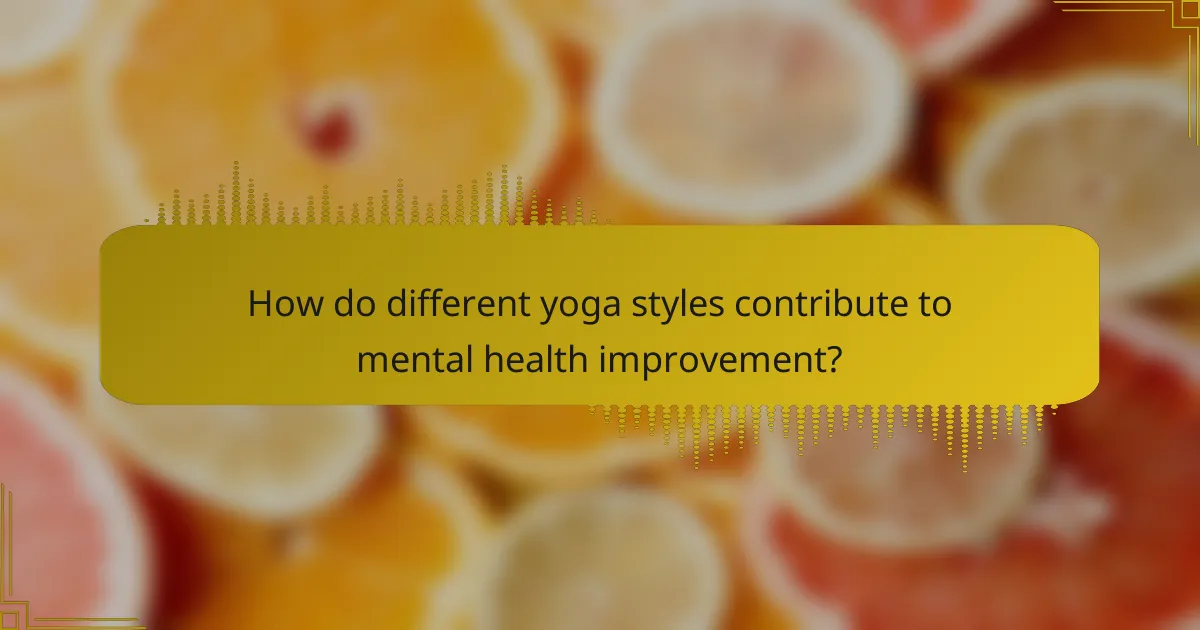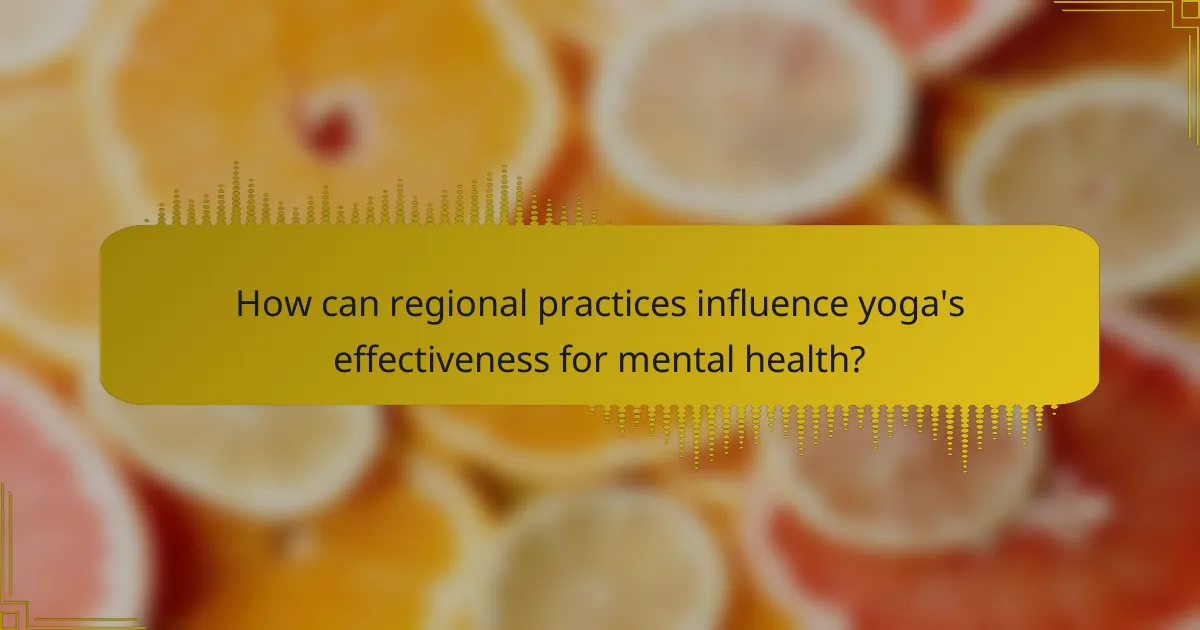Yoga styles can significantly improve mental health and emotional resilience. Hatha yoga promotes relaxation, Vinyasa encourages mindfulness, and Restorative yoga reduces anxiety. Ashtanga builds discipline, while Kundalini activates energy for emotional balance. Regional practices enhance these benefits by integrating local cultural elements and fostering community support.

How do different yoga styles contribute to mental health improvement?
Different yoga styles significantly enhance mental health through unique practices. Hatha yoga promotes relaxation and stress relief, while Vinyasa encourages mindfulness and emotional flow. Restorative yoga fosters deep relaxation, reducing anxiety. Ashtanga builds discipline, enhancing resilience. Kundalini activates energy, promoting emotional balance. Each style contributes distinct benefits for mental well-being.
What are the universal benefits of yoga for mental health?
Yoga significantly enhances mental health by reducing stress, anxiety, and depression. It promotes emotional resilience through mindfulness and improved self-awareness. Regular practice fosters a sense of community and belonging, which is crucial for mental well-being. Studies indicate that yoga can lower cortisol levels, contributing to stress reduction. Additionally, specific styles like Hatha and Vinyasa are particularly effective for emotional balance, offering unique benefits such as increased focus and relaxation.
How does yoga reduce anxiety and depression?
Yoga effectively reduces anxiety and depression through mindfulness, physical movement, and breathing techniques. These elements promote relaxation and emotional balance. Research indicates that consistent yoga practice can lower cortisol levels, enhance mood, and improve overall mental health. Various styles, such as Hatha and Yin, focus on gentle movements and meditation, making them particularly beneficial for emotional resilience. Additionally, yoga fosters a sense of community and support, further aiding mental well-being.
What role does yoga play in enhancing emotional resilience?
Yoga significantly enhances emotional resilience by promoting mindfulness and reducing stress. Various styles, such as Hatha and Vinyasa, focus on breath control and body awareness, which cultivate a sense of calm. Research indicates that regular practice can lead to decreased anxiety and improved mood regulation. Additionally, restorative yoga offers unique benefits by fostering deep relaxation, further supporting emotional stability. By integrating these practices, individuals can develop coping strategies that strengthen their emotional health over time.
Which unique yoga styles are particularly effective for emotional well-being?
Trauma-informed yoga, yin yoga, and restorative yoga are unique styles particularly effective for emotional well-being. Trauma-informed yoga focuses on creating a safe space for healing, addressing emotional trauma through mindful movement. Yin yoga promotes deep relaxation, allowing emotional release through long-held postures. Restorative yoga emphasizes gentle stretching and support, fostering a sense of safety and calm. Each style targets emotional resilience by enhancing body awareness and promoting mindfulness.
What are the specific attributes of Hatha yoga for mental health?
Hatha yoga enhances mental health through stress reduction, improved focus, and emotional stability. Its specific attributes include mindfulness practices, breathing techniques, and physical postures. Mindfulness fosters present-moment awareness, reducing anxiety. Breathing techniques regulate the nervous system, promoting relaxation. Physical postures improve body awareness and release tension. These attributes collectively contribute to enhanced emotional resilience and overall mental well-being.
How does Vinyasa yoga promote emotional balance?
Vinyasa yoga promotes emotional balance by fostering mindfulness, enhancing self-awareness, and encouraging emotional release through movement. The fluid transitions between poses create a meditative state, allowing practitioners to connect with their emotions. This style’s emphasis on breath synchronization can reduce stress and anxiety, leading to improved emotional resilience. Regular practice can cultivate a sense of inner peace, making it easier to navigate life’s challenges.
What makes Kundalini yoga unique in fostering resilience?
Kundalini yoga uniquely fosters resilience through its combination of breath control, meditation, and dynamic movement. This style enhances self-awareness and emotional regulation, empowering practitioners to adapt to stress. The focus on awakening energy helps individuals cultivate inner strength, promoting mental clarity and emotional stability. Regular practice can lead to significant improvements in coping mechanisms, making it a powerful tool for enhancing resilience.
What rare attributes of yoga styles can enhance mental health outcomes?
Certain rare attributes of specific yoga styles can significantly enhance mental health outcomes. For instance, Kundalini yoga incorporates breath control and chanting, which can lead to heightened emotional awareness. Restorative yoga emphasizes deep relaxation, promoting stress relief and emotional stability. Laughter yoga uniquely combines laughter exercises with yoga breathing, fostering joy and reducing anxiety. These distinctive features can create profound shifts in mental resilience and emotional well-being.
How do restorative yoga practices specifically aid in emotional recovery?
Restorative yoga practices significantly aid in emotional recovery by promoting relaxation and reducing stress. These practices encourage deep breathing and mindfulness, which help regulate emotions. Restorative poses support the body, allowing for prolonged relaxation that can release tension and anxiety. As a result, individuals often experience improved mood and emotional balance. Research indicates that consistent restorative yoga can enhance resilience and emotional well-being, making it an effective tool for recovery.
What unique techniques in Ashtanga yoga support mental clarity?
Ashtanga yoga employs unique techniques like synchronized breath and movement, which enhance mental clarity. These practices promote mindfulness, allowing practitioners to focus on the present moment. The structured sequence of postures also cultivates discipline, aiding emotional resilience. Additionally, the use of drishti, or gaze points, helps to center attention and reduce distractions.

How can regional practices influence yoga’s effectiveness for mental health?
Regional practices can significantly enhance yoga’s effectiveness for mental health by integrating local cultural elements and addressing specific community needs. For instance, traditional practices may include unique breathing techniques or meditation styles that resonate with local beliefs. These adaptations can foster a deeper emotional connection, promoting resilience and well-being. Additionally, community-based yoga programs often encourage social support, which is crucial for mental health improvement. By tailoring yoga styles to regional contexts, practitioners can experience more profound benefits, making yoga a versatile tool for emotional resilience.
What cultural adaptations of yoga styles enhance emotional resilience?
Cultural adaptations of yoga styles enhance emotional resilience by integrating local practices and philosophies. For instance, mindfulness-based yoga incorporates meditation traditions from various cultures, fostering deeper emotional awareness. Community-focused styles, like African tribal yoga, emphasize collective support, which strengthens social bonds and resilience. Additionally, styles like Kundalini yoga, rooted in Sikh traditions, emphasize energy flow and emotional release, enhancing mental well-being. These adaptations not only enrich the practice but also align with cultural values, making yoga more accessible and effective for diverse populations.
How does community yoga differ across regions in promoting mental health?
Community yoga varies significantly across regions in its approach to promoting mental health. Local cultures influence styles, practices, and community engagement. For instance, in urban areas, yoga may focus on fast-paced classes that emphasize stress relief, while rural settings often incorporate traditional practices that foster deeper connections to nature and community.
In regions with a strong emphasis on mindfulness, yoga sessions may integrate meditation techniques, enhancing emotional resilience. Conversely, areas that prioritize physical fitness may focus on vigorous styles like Ashtanga or Power Yoga, which can also contribute to mental well-being through physical exertion.
Furthermore, community support systems differ; in some cultures, group practices encourage social interactions that bolster mental health, while in others, solitary practices may be more common, emphasizing personal reflection.
Overall, the diversity in community yoga practices reflects a rich tapestry of cultural values and priorities, each contributing uniquely to the mental health benefits derived from yoga.
What are the best practices for integrating yoga into mental health routines?
Integrating yoga into mental health routines enhances emotional resilience and well-being. Focus on styles like Hatha for relaxation, Vinyasa for dynamic movement, and Yin for deep stretching. Each style offers unique benefits, fostering mindfulness and stress reduction. Regular practice can improve mood and decrease anxiety levels. Consider incorporating breathwork and meditation to deepen the effects.
How can individuals select the right yoga style for their emotional needs?
Individuals can select the right yoga style for their emotional needs by assessing their specific mental health goals. Hatha yoga promotes relaxation and stress relief, while Vinyasa offers dynamic movement that can uplift mood. Restorative yoga is beneficial for deep emotional healing, and Kundalini focuses on energy release and emotional balance. Each style addresses unique attributes that cater to different emotional states, making it essential to try various classes to find the best fit.
What common mistakes should be avoided when practicing yoga for mental health?
Common mistakes to avoid when practicing yoga for mental health include neglecting proper alignment, skipping breath awareness, and setting unrealistic expectations. Practicing without mindfulness can lead to physical strain and mental frustration. Additionally, not varying yoga styles may hinder emotional growth. Lastly, ignoring the importance of consistency can limit the benefits of yoga on mental health.
What expert insights can help optimize yoga practices for emotional resilience?
Practicing specific yoga styles can significantly enhance emotional resilience. Hatha yoga, known for its focus on postures and breathing, promotes relaxation and stress relief. Vinyasa offers a dynamic flow that helps release pent-up emotions through movement. Restorative yoga, characterized by gentle poses and long holds, fosters deep relaxation and emotional healing. Integrating mindfulness meditation into yoga practice can further cultivate self-awareness and emotional regulation. These insights encourage individuals to choose yoga styles that align with their emotional needs, ultimately improving mental health.